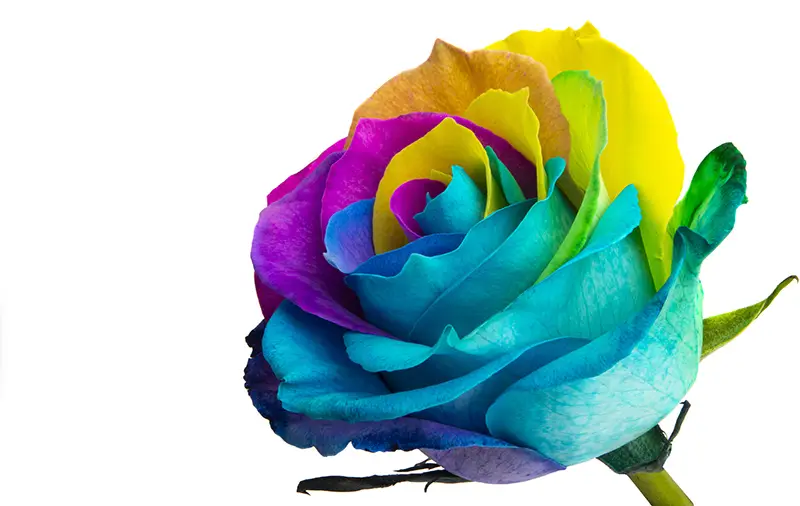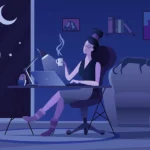With color selection being such an important part of creative professions and side-hustles, you would think that color blindness (also known as color vision deficiency) would act as a severe impairment. This isn’t actually the case, with several tools and techniques used by digital creatives every day to make color blindness a non-issue for them. Let’s explore these and how they can help you if you have color vision deficiency.
The effects of color blindness for digital creatives can be minimized using physical tools such as EnChroma glasses or screen saturation adjustments which help differentiate colors more easily. Using color palettes, color wheels and inspecting RGB values of reference images can make it easier to pick the right colors.
Types of Color Blindness
The different types of color blindness are caused by either compromised or missing red, green or blue cones in the eye.
The most common type of color blindness is a reduced ability to distinguish between greens and reds. There are four main categories:
- Deuteranomaly – Mild color blindness with greens appearing more like red.
- Deuteranopia – Unable to see greens
- Protanomaly – Mild color blindness with reds appearing more green and less vivid.
- Protanopia – Unable to see reds
Blue-Yellow color blindness is less common, with two categories:
- Tritanomaly – Blue and green appear less different and also between yellow and red.
- Tritanopia – Unable to see blue meaning differences between blue and green, purple and red and yellow and pink are less apparent.
Find out what type of color blindness you have by taking EnChroma’s color blind test here
Reference: National Eye Institute website.
EnChroma Glasses: Improve Color Differentiation
EnChroma manufacturer glasses with special lenses that filter certain wavelengths of light. This makes it easier for wearers with color blindness to distinguish between colors that normally cause problems.
The glasses will work differently depending on the severity and type of color blindness you have so pay attention to EnChroma’s guidance when purchasing to choose the right version.
Check the latest prices and reviews on Amazon here (paid link).
Take a look at Tech Insider’s video about the EnChroma Glasses below:
Check RGB Values of Reference Images
A great hack that digital creatives can use is to grab a number of reference images of your chosen subject and check the RGB values of areas you need help with. This can easily be done with the color-picker tool (eye-dropper) in Adobe Photoshop or similar software.
You can then take a note of the RGB ranges to use in your artwork or save them as a palette. Over time you will get to know certain ranges that correspond to particular skin tones or vivid blue skies, etc.
Use Color Theory
Color theory helps select colors that work well together or convey a particular emotion. Using color theory can help color blind designers (and non-color blind ones for that matter) avoid mistakes in color selection.
Selecting colors from a color wheel and understanding what their relative positions mean can help ensure your designs convey what you intend.
Knowing that complementary colors will be opposite each other on the color wheel allows designers to check their selection of colors don’t clash and are visually appealing.
Similar colors will be next to each other on the color wheel and can be used to convey a temperature or emotion.
Triadic colors will form a pyramid on the color wheel and offer eye-catching color selections that can create great logo palettes for example.
For an explanation of basic color theory, check out an excellent post about color theory on 99designs here.
Color Palettes
However you have selected the colors that are right for your project, you can save them as a color palette, along with their Hex and RGB values and any other labels you wish. It is good practice to make one for each project you are working on.
When you need to color an area you can now pick from your color palette to ensure that you are choosing the right color each time. This will help avoid picking something that you find hard to distinguish by eye.
Adobe Color
Adobe Color is a tool for making color palettes and has a lot of useful in-depth features that can help a color blind digital artist.
You can browse a library of pre-made color palettes which could help you to choose colors that you know already work well together.
The tool also allows you to upload your own image and automatically extract a color palette for you.
Alternatively, use the color wheel to create your own color palette according to color theory and export or save it for later usage.
Visit the Adobe Color website to use the tools for free.
Change Hue and Saturations Levels
If you have mild color blindness it can help to adjust the hue or saturation of the colors you are working on. For some, this helps to distinguish between them better.
This can be achieved with a Hue Saturation layer in Photoshop for example.
In addition, programs such as Visolve will apply screen-wide color adjustments to allow color blind users to distinguish them more easily.
Color Inspector App
If you have an iPhone then you might find the Color Inspector App useful.
Simply point the camera at your choice of subject and it will tell you what color and color family it is using live video.
Tools to Design for Colorblind Users
Even if you are not a colorblind designer yourself, having the ability to ensure your work is accessible to those that are is critical. Thankfully, there are a number of tools available to check your designs.
One such tool that you may already have is built into Photoshop. Go to View -> Proof Setup -> Color Blindness Protanopia-type or Color Blindness Deuteranopia-type. The feature only covers the most common types of color blindness but it’s a great start. It enables you to view the design as someone with this type of color blindness would to ensure that it still looks as you intend.
If you’re designing for web then a really great tool which does a similar thing is the Colorblind Web Page Filter from Toptal. It’s free and very easy to use. Simply enter the url of the page you want analyzed and select the type of color blindness to check for. It even evaluates the less common Tritanopia. After processing it shows side-by-side full-length images of the non-colorblind and colorblind versions of the page for comparison.
Conclusion
It can feel intimidating as a color blind digital creative, especially if you’re trying to keep it a secret. There are however many designers out there that operate just fine with their color blindness using tools and techniques such as the ones mentioned here.
If you found this post useful then you might be interested in Essential Gear for Digital Creatives: Complete Guide and Adobe Creative Cloud: Apps and Tools Explained.
Featured image: ksena32 / stock.adobe.com
Adobe, Adobe Color, Creative Cloud, Lightroom, Photoshop, Photoshop are either registered trademarks or trademarks of Adobe in the United States and/or other countries.








